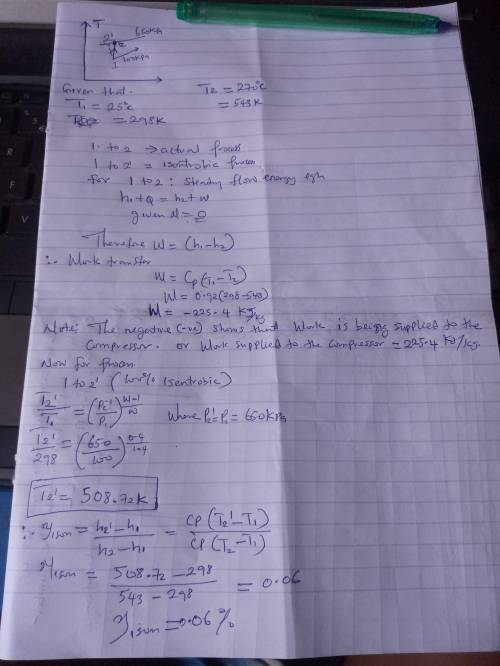
Engineering, 06.04.2020 18:36, GrainLeaf
Oxygen is compressed from an initial state of p1 = 1 bar, T1 = 25◦ C to a final state of p2 = 650 kPa, T2 = 270◦C in a compressor operating at steady state. Model the oxygen as a perfect gas with γ = 1.4 and cp = 0.92 kJ/kg·K. Neglecting stray heat transfer and kinetic and potential energy effects, determine: (a) the work, in kJ per kg of oxygen flowing through the compressor. (b) the isentropic efficiency η for the compressor.

Answers: 3
Other questions on the subject: Engineering

Engineering, 04.07.2019 18:10, yasminothman02
An air conditioning system consist of a 5 cm diameter pipe, operating at a pressure of 200 kpa. the air initially enters the pipe at 15°c with a velocity of 20 m/s and relative humidity of 80%. if the heat supply throughout the process is 960 w, determine the relative humidity and the temperature at the outlet
Answers: 3

Engineering, 04.07.2019 18:10, lerasteidl
Determine whether or not it is possible to compress air adiabatically from k to 140 kpa and 400 k. what is the entropy change during this process?
Answers: 3


Engineering, 04.07.2019 18:10, Tyrant4life
Draw the engineering stress-strain curve for (a) bcc; (b) fcc metals and mark important points.
Answers: 1
Do you know the correct answer?
Oxygen is compressed from an initial state of p1 = 1 bar, T1 = 25◦ C to a final state of p2 = 650 kP...
Questions in other subjects:



Mathematics, 30.09.2019 21:00


History, 30.09.2019 21:00











